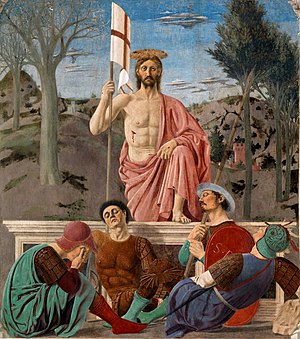The Resurrection (Piero della Francesca)
| Resurrection | |
|---|---|
 |
|
| Artist | Piero della Francesca |
| Year | c. 1460s |
| Type | Fresco |
| Dimensions | 225 cm × 200 cm (89 in × 79 in) |
| Location | Museo Civico, Sansepolcro |
The Resurrection is a fresco painting by the Italian Renaissance master Piero della Francesca, painted in the 1460s in the Palazzo della Residenza in the town of Sansepolcro, Tuscany, Italy.
Piero was commissioned to paint the fresco for the Gothic-style Residenza, the communal meeting hall which was used solely by Conservatori, the chief magistrates and governors, who before starting their councils, would pray before the image. "The secular and spiritual meanings of the painting were always intimately intertwined." Placed high on the interior wall facing the entrance, the fresco has for its subject an allusion to the name of the city (meaning "Holy Sepulchre"), derived from the presence of two relics of the Holy Sepulchre carried by two pilgrims in the 9th century. Piero's Christ is also present on the town's Coat of Arms.
Jesus is in the centre of the composition, portrayed in the moment of his resurrection, as suggested by the position of the leg on the parapet of his tomb, which Piero renders as a classical sarcophagus. His stern, impassive figure, depicted in an iconic and abstract fixity (and described by Aldous Huxley as "athletic"), rises over four sleeping soldiers, representing the difference between the human and the divine spheres (or the death, defeated by Christ's light). His figure in the commune's council hall "both protects the judge and purifies the judged" according to Marilyn Aronberg Lavin. The landscape, immersed in the dawn light, has also a symbolic value: the contrast between the flourishing young trees on the right and the bare mature ones on the left alludes to the renovation of men through the Resurrection's light. Andrew Graham-Dixon notes that apart from the wound, Christ's "body is as perfectly sculpted and as blemish-free as that of an antique statue. But there are touches of intense humanity about him too: the unidealised, almost coarse-featured face; and those three folds of skin that wrinkle at his belly as he raises his left leg. Piero emphasises his twofold nature, as both man and God."
The guard holding the lance is depicted sitting in an anatomically impossible pose, and appears to have no legs. Piero probably left them out not to break the balance of the composition.
...
Wikipedia
